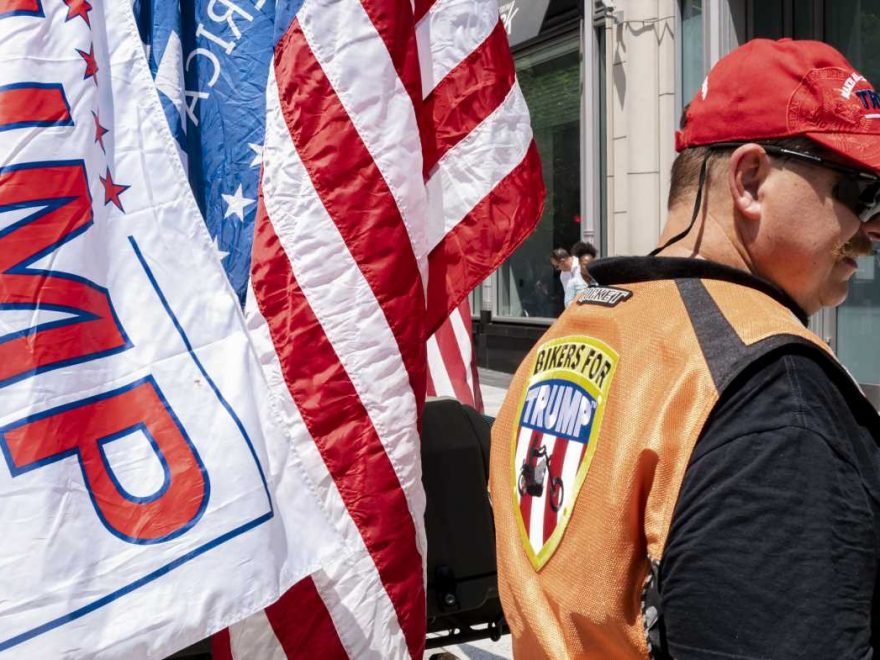On July 2, while much of the country was caught up in a bitter argument about whether President Donald Trump’s “Salute to America” 4th of July rally was a massively egotistical and expensive folly, the entire center of Washington, DC, was overrun by hundreds of thousands of Trump zealots who had arrived by plane, train, motorcycle, and even caravans of pickups hauling horse trailers from as far away as New Mexico. And if there was a locus for the chaos of the long holiday weekend, it was the Hotel Harrington. The shabby tourist stop, located just a few blocks from the White House, took on the air of a raucous festival for people who believe in civilizational conflict, complete with reunions of old friends and a swelling anticipation for the headline act.
Across the street from the hotel, a sagging old pickup — trailed by a parade-style float on a 50-foot-long motorcycle trailer, with giant white letters reading “TRUMP” and “BUILD THE WALL” — was blasting country and dance hits through streets full of MAGA-hatted revelers well into the early hours of the morning. This giant contraption, known to the #MAGA faithful as the Trump Unity Bridge, has traveled tens of thousands of miles to protests and rallies in the last few years.
On the patio of Harry’s, the ground-floor dive bar at the Harrington, a group of blue polo–clad Proud Boys entertained a group of wildly drunk ultra-right-wing Ukrainians who kept falling off their stools, even as they yelled to the servers to bring them more beer. One Proud Boy was wearing a black Iron Cross as a necklace outside of his polo. I asked if it was what I thought it was, and he said “Yeah, man” without any hesitation. “It’s from World War I, so it’s not a racial thing,” he went on. “It’s just that I’m German.”
“I think Trump is gay,” he said, using the word in its pejorative, not descriptive, sense. “But we’re conservatives, and we try to make an appearance at all the conservative events. This is fun for us.”
I was surrounded by a crush of people wearing Trump paraphernalia of all descriptions, from bikini tops to pink suits stenciled with the words “Gays for Trump,” as they ordered pitcher after pitcher of beer. But they barely had time to drink because they would continually burst into chants of “Build the wall” or “U-S-A” or — the runaway favorite — a simple staccato of “TRUMP! TRUMP! TRUMP!” accompanied by a great deal of clapping and banging of empty glasses. Harry’s had become a #MAGA safe space, and they were loving it.
I had come to the Harrington to try to meet Chris Cox, the leader of a group that has quietly become one of the president’s favorite political vehicles, Bikers for Trump. Like most people, I only had a hazy image of the Bikers, but had been following the president’s occasional public shoutouts to them and noticed how men and women on motorcycles wearing the Bikers’ signature patches had become ubiquitous, even at small and out-of-the-way right-wing rallies or protests. In time I would learn that the group is not even really an organization, in the sense of having membership rolls and mailing lists, but rather functions as a loose but sophisticated organizing structure of closed Facebook groups.
These groups are overseen by a die-hard national leadership — some of whom were, I knew from scrolling through Facebook, staying at the hotel in the lead-up to Trump’s rally that week. And through Facebook, Bikers for Trump leaders moderate and coordinate the participation of tens of thousands of Trump’s most fervent supporters in campaign work, at rallies — and, to some extent — in the rough street politics of our new age, which plenty of the Bikers take to with relish. But the leadership of the Bikers is careful to make sure it doesn’t get too mixed up in this sort of thing, because it would greatly undermine the viability of the political machine these burly men and rowdy women have built up in the last few years, effectively becoming one of the most dedicated and potent cadres in the Trump revolution.
The Bikers have coordinated at least informally with the Republican National Committee since before Trump’s nomination, and they say they have accumulated the thanks of half a dozen Republican senators and governors, for whom the Bikers’ zealous support was a key factor in close races. But the group’s loyalty ultimately flows to the president, the man who drew most of its members into politics in the first place — and in response, Trump has shown them an apparently deep and genuine personal gratitude. “No matter where I go, there’s bikers,” Trump once noted with wonder in his voice. “And I’d ask my people: What are they all doing here? And they’d say, ‘They’re here to protect you, Mr. Trump’ …’
“Some of the guys I see out on the [bikes] are rough,” he went on. “And I get out and I shake their hands and … I’ll tell you: There is love. It’s an incredible feeling.”
Cox, who recently announced that he’s running for Congress in South Carolina, meets often with Trump. Dale Herndon, a former deputy for the Bikers, who had previously worked as a warden of a maximum security prison, is now its director and has taken over the day-to-day running of the Bikers while Cox is occupied with campaigning. He will prepare the Bikers to play a bigger role in the 2020 elections and whatever may come after. Herndon had introduced himself to me in the hotel lobby the night I checked in. “You know we have 80,000 people on the active lists now?” he said. “And tomorrow we’re going to do training with the RNC.”
I finally met Cox, who had yet to respond to my repeated interview requests, on the second night of my stay at the Harrington. He was stepping into the elevator as I got out; when I realized who it was, I said hello. We shook hands, and he told me the deal. It turned out that he and Herndon had discussed the idea of talking to me that morning — going so far as to look up some of my writing — but had decided against it. Cox is tall and neatly groomed, extremely fit at 51, and speaks with a slow drawl and slight lisp. Though I had seen plenty of his videos online, in person he turned out to be a surprisingly imposing physical presence. “It’s nothing personal,” he said, “but I’ve dealt with a lot of these places,” meaning media outlets.
“They’ll frame us as crazy, violent vigilantes and whatnot because what they need is to get all that traffic,” he continued. Cox, who brought his Bikers to form what he called a “wall of meat” against protesters trying to disrupt Trump’s inauguration in January 2017, and who said that they “served many knuckle sandwiches” that day, now seems acutely aware that headlines framing the Bikers as roughhousing vigilantes does not help his deepening relationship with Trump or the Republican Party, and he’s become much more careful.
The conversation was rigorously polite but slightly testy, and while it seemed clear that he’d prefer it if I just went home, Cox knew he couldn’t stop me from hanging around if that’s what I wanted to do. “You have free speech like I do,” Cox said. “I can’t stop you from exercising that.”
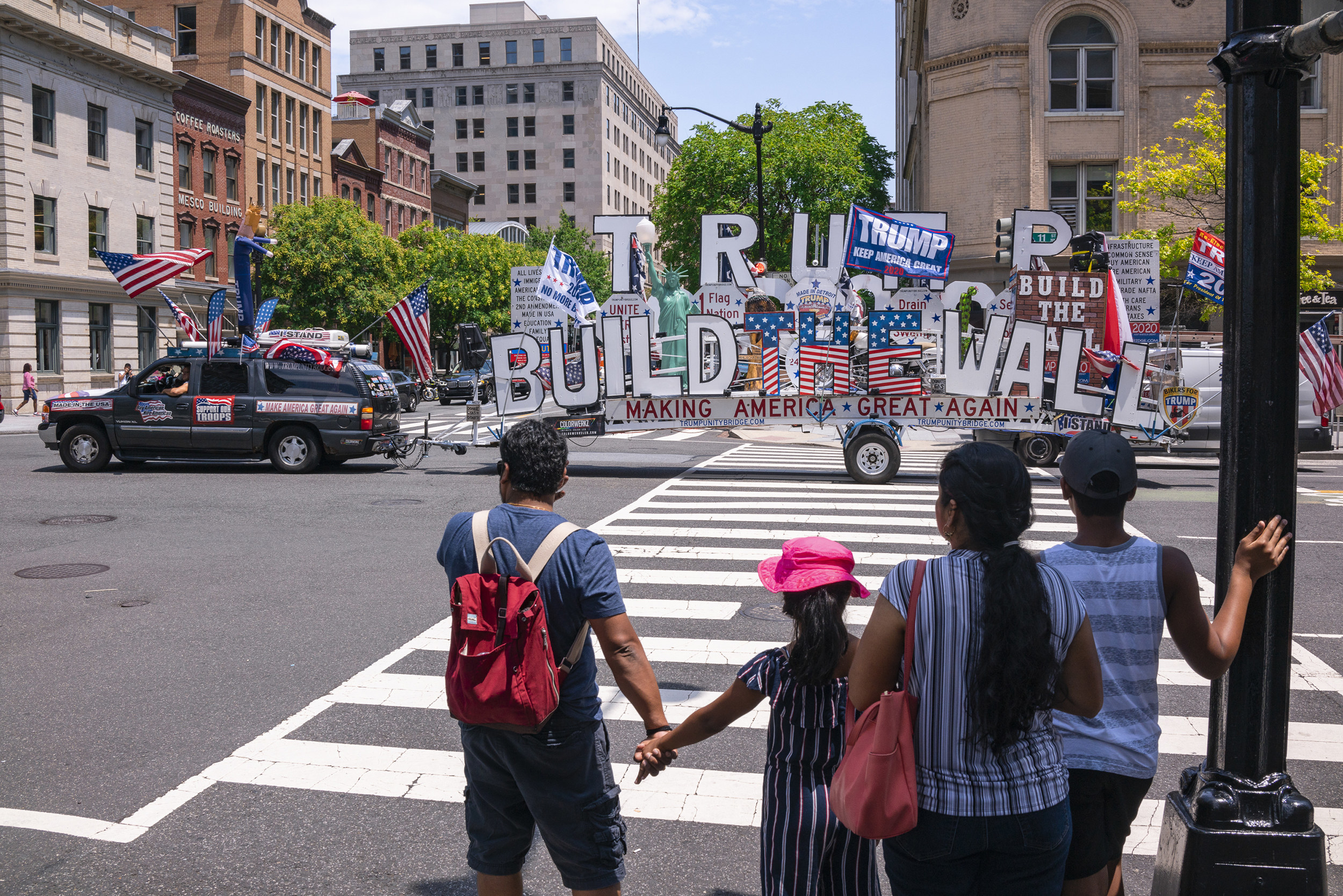
A family watches as the Trump Unity Bridge passes through downtown Washington, DC, July 4, 2019.
Back in 2011, when he first started popping up in the news, Chris Cox was a semi-itinerant chainsaw artist with a wild beard, a frazzled mop of graying hair, the build of an ogre, and the deep tan of someone who spent a great deal of time out in the sun. He sold cypress logs carved into the shapes of dolphins and sea turtles (his specialty) from a big red truck that became a recognizable sight in the Charleston suburb of Mount Pleasant, South Carolina.
He was born in Raleigh in 1968 and raised in Northern Virginia, where he got his first motorcycle — a tiny Honda with no clutch — in kindergarten. He has been riding ever since. Shortly after Cox finished high school, his family, having long roots in the Charleston area, moved back to Mount Pleasant. They occupied a genteel house and a comfortable place in upper-middle-class South Carolina society.
In college, Cox took on work limbing and clearing trees downed in hurricanes — a delicate and often dangerous occupation that requires a sawyer to be deft and gentle with a heavy machine that sometimes seems like it bucks and dances of its own free will. And in 1999, he saw a chainsaw-carved tiki head and thought he could do one better. Suddenly — somewhat to the dismay of his very proper family — he started looking up famous chainsaw artists and asking for apprenticeships. He began selling his sculptures by the roadside around Charleston, and eventually in party spots like Virginia Beach as he grew into the métier. He was often broke, but sometimes sold a single piece for thousands of dollars.
He had a love for ginning up attention by any means available, from hosting a local TV reporter who filmed him shouting Washington Redskins fight songs and using a chainsaw to cut off a pair of laced-up boots from his own feet, to going around pitching the idea of a chainsaw-art reality show called Hard Wood.
The wild-man persona of his chainsaw days helped Cox paint a convincing picture of himself as a down-home outsider. But he had actually been around high-level politics long before Trump ever decided to run for president — since he was barely old enough to drink, in fact. His father was a veteran Republican operative named Earl G. Cox, who worked for four presidents and had various roles under Ronald Reagan, including director of information and public affairs for the departments of Labor and Agriculture. In the early ’90s, the younger Cox took a job as an advance man for then–vice president Dan Quayle. He scouted event locations, dealt with members of the White House Communications Agency, helped plan events, and learned how to make contacts and promote events — and get people to actually show up for them — all skills that would become useful later. (He went on to work for Colin Powell in 1996 and Elizabeth Dole in 2000.)
In 2013, during the government shutdown, Cox grew into a minor internet sensation known as “Lawnmower Guy,” when he brought his push mower up to DC and cut the unkempt grass around the Lincoln Memorial, looking a bit unkempt himself and sounding aw-shucks earnest in interviews. “He’s a real American hero, if you ask me,” wrote BuzzFeed News’ Ryan Broderick at the time. Cox then set about crafting a bill to ensure the upkeep of war memorials during government shutdowns, meeting with hundreds of members of Congress until he found a bipartisan group of cosponsors. (The bill is still stuck in committee.) This brush of viral celebrity led to right-wing biker groups — there were already quite a few of these, with names like Bikers Against Radical Islam and Defenders of Liberty MC — getting in touch and asking Cox to appear at rallies. As Cox kept hanging out with more riders and began going to Trump events, he thought about uniting bikers under one political banner. He had, after all, been riding all his life, though always as a “lone wolf” who refused to join a biker club.
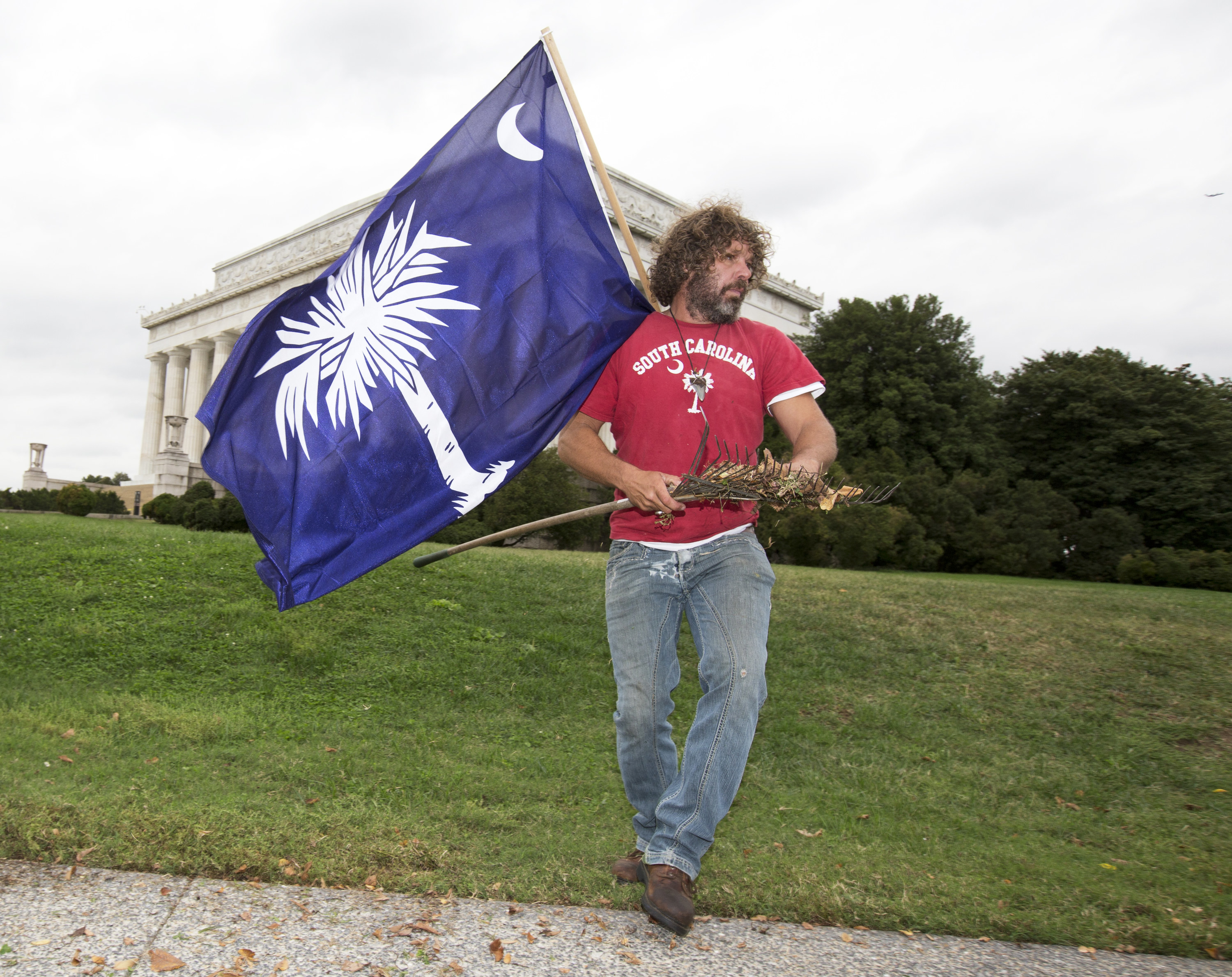
Chris Cox picks up dried leaves he raked near the Lincoln Memorial in Washington, DC, Oct. 9, 2013.
There are more than 8 million registered motorcycles in this country, and there are groups from black biker clubs in Brooklyn to outlaw One Percenter motorcycle gangs in California and an uncountable number of other subcultures centered around the activity of riding two-wheeled motorized vehicles that cut across basically every line imaginable of age, ethnicity, class, and gender. But when Cox talks about “bikers,” he’s generally referring to a class of mostly white, middle-class, and older riders who frequent biker bars, show up at rallies in Sturgis, South Dakota, or Laconia, New Hampshire, or on the Rolling Thunder ride into DC. Cox’s idea of riders like to think of themselves as flag-waving, good-timing, hardworking people who respect authority when it’s warranted, but who take no bullshit and get rowdy if someone crosses the line.
They are not often rich, but they are usually comfortable — the owner of the Buffalo Chip, a famous biker campground and event venue in Sturgis, recently told CNN that his average camper makes $95,000 a year and owns a home and more than one motorcycle. “In Sturgis,” the CNN reporter wrote, “the definition of diversity is a white guy on a foreign bike.”
These bikers like ’70s rock and kitschy, flag-adorned Americana and they exalt veterans. Many of these bikers are themselves veterans, and the ones who aren’t tend to have a view — lingering from the political and cultural wars around the Vietnam War — of veterans as a class of people abandoned and disdained by liberal America, whom bikers have a duty to respect and support. The annual Rolling Thunder biker rally, which began in 1987 and last year drew half a million riders to Washington, DC, shares a name with President Lyndon Johnson’s brutal bombing campaign of North Vietnam from 1965 to 1968. It started off as a rally to bring attention to the damaging lie that a string of Republican and Democratic administrations had ignored evidence that the Vietnamese government was secretly imprisoning living American service members listed as missing in action.
These bikers were, in other words, people predisposed to like presidential candidate Donald Trump. They liked him not just because he talked constantly about taking care of veterans or because said he was going to build a wall or keep Muslims out of the country, though the bikers Cox met tended to like this too. “It did seem odd,” the Washington Examiner later observed, “that a group of rugged ex-vets and tattooed blue-collar types would endorse a draft-avoiding, necktie-selling Manhattanite who prefers riding in limos to mounting motorcycles. But there was something about Trump that resonated with these bikers.”
They were drawn to Trump because they identified with him, in the way a college freshman might identify with a protagonist in a Hemingway novel — because they imagined a shared general outlook on life and a way of being in the world they wanted to emulate. “We like him because he says what he thinks, he loves America, and he doesn’t take any shit from anybody,” one Biker for Trump named John Balazek, a 55-year-old welding inspector at a Maryland power plant, told me. “That’s how bikers are too.” (Rolling Thunder explicitly endorsed Trump, who spoke at the 2016 rally. The founder and executive director of the group recently called Nancy Pelosi an “arrogant little bitch,” threatening that bikers might roll en masse into DC if she launched impeachment proceedings.)
No one had ever really tried to organize bikers qua bikers before. But any group that can regularly summon hundreds of thousands of people — who share a political ideology and have enough time and disposable income to buy multiple Harleys and attend distant rallies — represents a potentially massive force for political organizing. It’s the kind of political energy that builds movements and wins primaries.
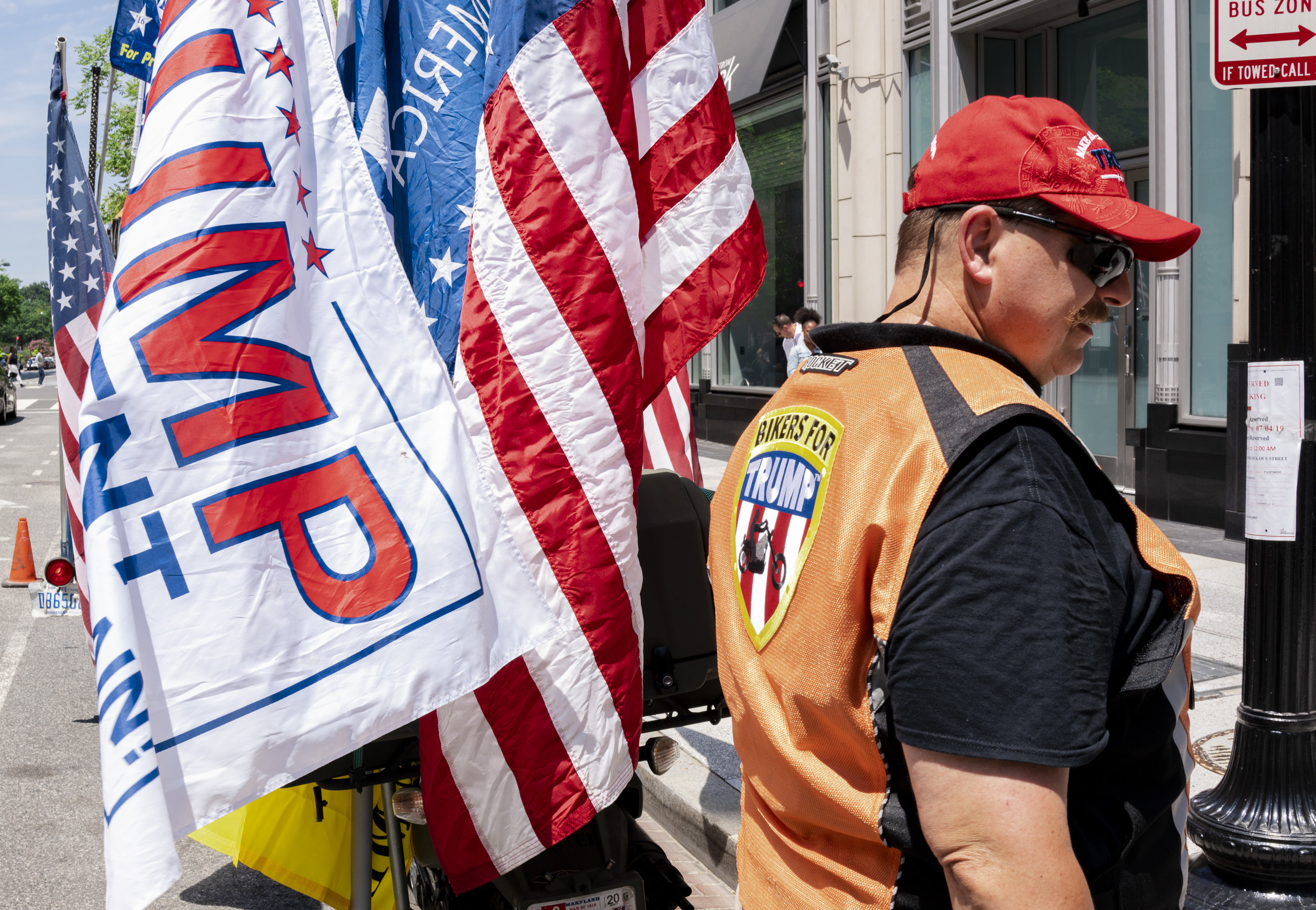
John Balazek, a member of Bikers for Trump, stands in front of his bike.
In November 2015, Cox began touring biker bars on the Eastern Seaboard, at a point in the 2016 presidential campaign when most respectable observers still thought Trump’s candidacy was a bizarre stunt, and no major Republican figures or political groups had endorsed him. It turns out that that didn’t matter. Trump was running on visceral political energy, and Cox set out to find people who could help supply that energy. Everywhere he went, he’d bring a stack of Trump stickers to hand out; they’d be snatched up and stuck on bikes and trucks. He kept hearing the same refrain: “He tells it like it is. He wears it on his sleeve.”
He found that 9 out of 10 bikers he talked to were Trump fans, and so he threw his first “9 out of 10 Bikers for Trump” rally in November 2015 at a bar called Boneshakers, in Virginia Beach. Its success led him to Florida, where he threw a rally in Daytona and then another at the gigantic High Octane Saloon in Homosassa. This got him his first media coverage, in the form of a short blurb and some photographs in the Tampa Bay Times. He’d learned the fundamentals of throwing rallies while working as a political advance man for Quayle. When he started pulling together Bikers for Trump, he knew that biker bars, which are now often more like sprawling entertainment complexes than they are grungy roadside dives, were perfect venues: They had parking, built-in stages, and social media reach. And they let him throw rallies for free since he was boosting drink sales.
Soon after, Cox headed up to Ohio and Pennsylvania, back down to South Carolina and Virginia, and then out to California. He was sleeping in a 1968 slide-in camper that he’d strapped down to the trailer he used to haul his logs and chainsaws, because he was still carving wood to pay for his gas and bar bills and everything else. “As long as I’ve got a couple logs and a chainsaw, I can turn them into something that can typically put some gas in my truck and a pillow under my head,” he told Fox News. He was unmarried, had no kids, and had registered the Bikers for Trump as a for-profit LLC to his mother’s baronial $1.2 million home in Mount Pleasant.
By the time he made his way up to Sturgis, in August 2016, where tens of thousands of Trump fans were assembled for a rally at the Buffalo Chip, Cox had built a phenomenon. His bikers rolled into Trump rallies, sometimes 2,000 or 3,000 strong, acting as an ad hoc security force, throwing out unruly protesters, and taking it upon themselves to cordon off anti-Trump protesters outside. Sometimes they openly carried sidearms; one Biker told the Guardian in July 2016, “We protect the police as much as the police protect us.”
This was when every Trump rally was a fervid scene of just-contained chaos, and it became a core part of the Bikers’ self-image that they were bigger and tougher than the snowflaky protesters who wanted to disrupt things. “Until we got involved, you could barely have a Trump rally without antifas shutting it down,” Balazek, who’s such a big man that it didn’t seem incongruous that he walked around drinking beer straight from a pitcher, said to me. “I always say: One Biker equals one antifa riot.”
But the Bikers didn’t engage in much actual violence at Trump’s rallies. Part of their, and Trump’s, core ideology is an almost worshipful respect for the authority of law enforcement, which they believe is under a terroristic assault from left-wing groups and Black Lives Matter. The Bikers coordinated their arrival with state police forces and eventually the RNC. They took pains to project themselves less as outlaw bullies than as a force for order — although a historically minded observer might say that they were part of an American tradition extending from 19th-century slave patrols to cowboy vigilantes to 20th-century gun thugs used to break up strikes that has seen groups of (generally) white men being allowed to operate as extralegal security or paramilitary forces, with implicit or explicit acceptance from forces of power or the state.
The Bikers delighted Trump — he later made quite explicit his pleasure at having supporters who were bigger, tougher, manlier, more American, than the opposition. He started to ask who they were. Trump also began asking to meet Cox. The first few times, Cox sent another person to meet Trump in his place in order to build loyalty and leadership among the Bikers. He also claimed he was too busy coordinating the swelling movement to give over hours waiting in a long line of retainers and sycophants who wanted to meet the candidate after every rally. Standing in line wasn’t his idea of “making a difference.”
The Bikers drew mainstream media attention in the form of alarmed-sounding pieces with headlines like “The Vigilantes Who Patrol Trump’s Rallies” and “Donald Trump Is Backed by an Ultra-Nationalist Biker Gang, Just Like Vladimir Putin,” the latter comparing them to the Night Wolves, a Russian biker gang, which in addition to running rock clubs and a clothing line has reconstituted itself as an almost paramilitary arm of the Russian state.
In 2013, members of the Night Wolves rolled across the Ukrainian border during the Russian seizure of the Crimean Peninsula, patrolling the streets alongside Russian soldiers, and fought on the side of pro-Russian rebels in the eastern Donbass region. The president of Chechnya, Ramzan Kadyrov, joined the group in 2014, while the Night Wolves’ leader, Alexander Zaldostanov, is a frequent guest at the Kremlin and was awarded a military medal for his role in the invasion of Crimea.
This comparison was a bit too simplistic, in part because the Night Wolves were an already extant motorcycle gang, with diverse business interests and loyalties that Vladimir Putin had slowly co-opted into his state apparatus. The Bikers, on the other hand, were building a political operation to fit the needs of Trump and only Trump, and they were doing it in real time. But you do not have to be a Russia-obsessed conspiracy theorist to find in their shared aesthetic the new style of an old political impulse. In 2012, after Pussy Riot staged a protest in Moscow’s Cathedral of Christ the Saviour, the Night Wolves offered to protect churches around the country from “hooligans” — exactly the sort of thing you could see the Bikers signing up for.
It’s hard to say how much impact the Bikers had on Trump’s primary win. This is partly because no one at the time really understood who they were or how they were organized, and partly because it wasn’t until Trump had essentially locked up the nomination that the American political media realized that Trump had been drawing on intense personal loyalty from people like the Bikers to win the presidency.
Trump himself clearly thought they played a role in his ascent. In June 2016, Trump finally spotted Cox at an event at his New Jersey golf club. “Come here, young man,” Cox said Trump told him. “I’ve been wanting to meet you — come back and have dinner with the family tonight.” On July 16, three days before the Republican National Convention where Trump accepted the nomination, he tweeted: “Thank you to Chris Cox and Bikers for Trump – Your support has been amazing. I will never forget. MAKE AMERICA GREAT AGAIN!”
But Cox had a much grander vision for himself than just blockading protesters outside rallies. He wanted to be a player in a political revolution. “I saw an opportunity to reinvent the party,” he told the New York Times in 2016. “I spent all my money on it and about 90% of my time on it.” Trump, and in turn the Republican Party, worked assiduously to cultivate the bikers as ultra-loyalists.
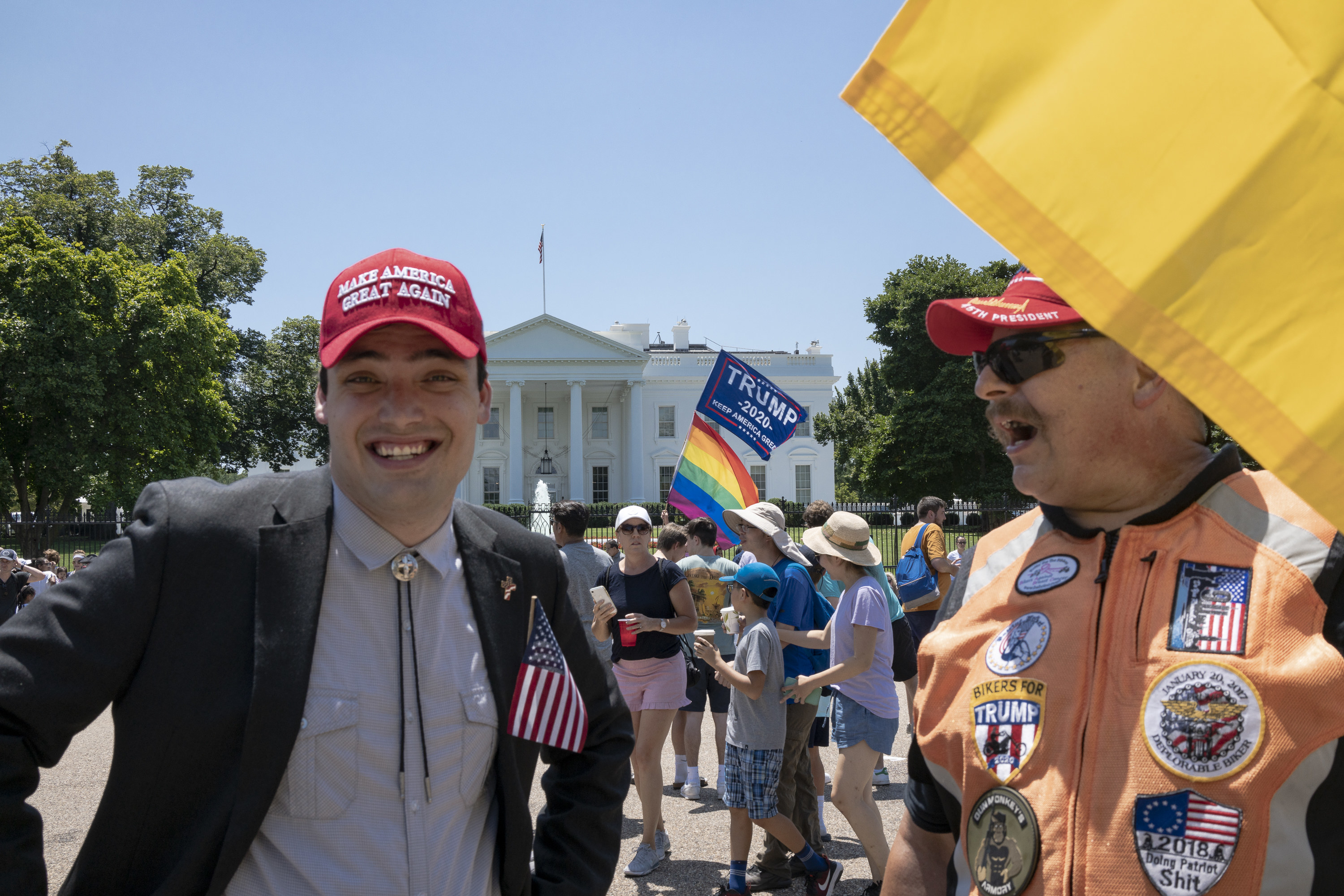
Trump supporters, including bikers, in front of the White House, July 3, 2019.
When I stepped out of the Harrington on the morning of July 3, the streets of DC were already swamped with Trump’s most fervent supporters. A riot of flag-waving middle-aged men and sweaty red-shirted MAGA families peeked into the lobby of the Trump International Hotel to gawk in hushed delight. Others were fading in the heat as they waited to get into Ford’s Theatre, or posed endlessly for pictures next to the Trump Unity Bridge, which had already started up its loudspeaker and was blasting loops of live Trump speeches and the old Confederate anthem “Dixie.” I was looking for Cox, but before I could find him I got to talking to John Balazek.
He was going to leave his Kawasaki dirt bike, outfitted with imitation machine guns and Claymore mines, by the Unity Bridge and walk over to the White House “just to wave [his] flags over there for a while.” He picked up a flagpole — to which he’d affixed Gadsden and Trump flags — and we walked toward the White House, passing a young woman on a bike who saw Balazek’s gigantic high-visibility yellow vest, adorned with Bikers for Trump patches, and gave him the finger. “Love you too, and nice tail,” he shouted as she went by. Moments later, we passed a white man wearing a T-shirt that said “Blacks Commit Hate Crimes and Say Racist Things Too,” who gave Balazek a silent thumbs-up, which he acknowledged with a nod.
“We’re just a bunch of bikers who love the president,” he told me before launching into a merry inventory of the huge guns he owns back in Maryland and relaying some war stories of battling “antifas,” which is what he called pretty much anyone who got into it with him at a rally.
He showed off a MAGA hat — the president had signed it in 2017 after inviting 175 of the Bikers’ state leaders to Bedminster, New Jersey. “He brought us all inside the clubhouse and gave us beer and sausages. He asked what we thought of the media and we were like, ‘Send them out in the rain!’ We were all around them chanting, ‘Fake news! Fake news!’ That was the most appreciated I’ve ever felt by anyone,” Balazek told me. When I expressed shock that there even were 175 state leaders, which seemed like quite a lot, he laughed. “There’s more than that,” he said. “We’re a political movement.”
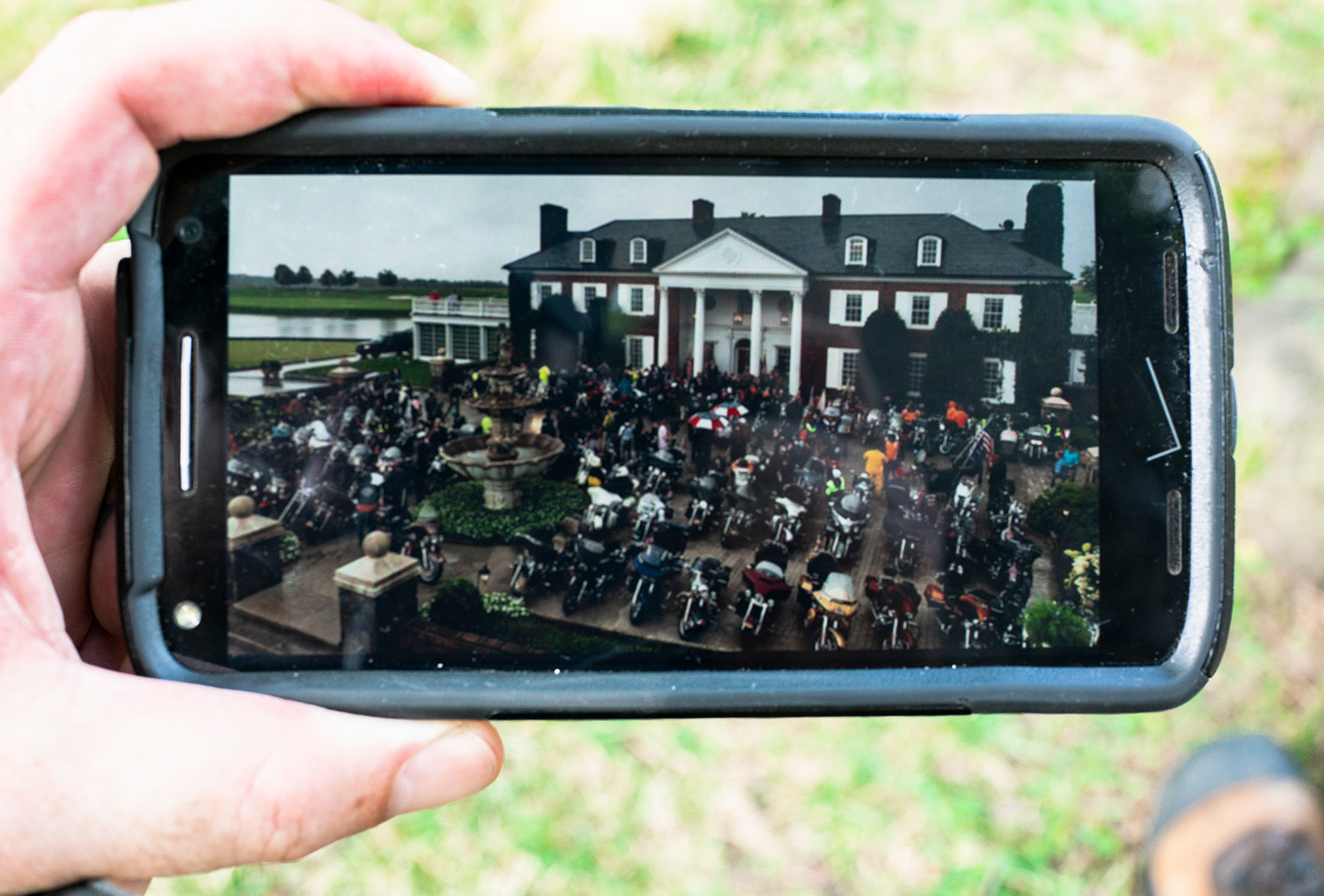
John Balazek shares a photo of the large crowd of motorcycles parked in front of Donald Trump’s golf resort in Bedminster, New Jersey.
When I met Londa Gatt back at Harry’s later that afternoon, she was showing off an iPhone photo of herself posing with the president. In it, Trump smiles a bit uneasily toward a throng of leather-clad men holding up clenched fists and iPhones; he curls his arm around a woman who looks, when she’s in her full getup, like a casting director’s vision of a no-bullshit woman biker — leather vest and bejeweled black headband above thoughtfully coiffed blonde hair. She’s middle-aged, lives and works in exurban Detroit as a part-time in-home nurse and hairdresser, and not long ago switched from riding dirt bikes to a Harley. To a large degree her social world has been shaped by being a member of the biker world, which has allowed her to meet friends at charity rides she helps organize, and see the country by traveling to big rallies and biker get-togethers.
Until Cox and Trump came around, none of this activity was organized around politics. She told me that she had never, until Trump ran for president, done anything more political than casting a vote. But now she suddenly found herself occupying a curiously important role in America’s wild new politics, one that she herself seemed to hardly believe. “We’re gonna go up onstage with him tomorrow,” she said. I mumbled something noncommittal, and she leaned back and punched me accusingly on the shoulder. “You don’t look excited!”
Gatt is the Bikers’ Midwest regional coordinator, and her role is a good illustration of how the group actually works — and how they plan to mobilize for Trump’s 2020 campaign. She is one of the Bikers’ seven national leaders, and oversees a swath of these groups that stretches from the Canadian border down to the mid-Atlantic. “My moderators will host rallies, and then I’ll go there to support them and to support the candidates,” she said. “I’ve been to Florida like five times for Ron DeSantis. We helped swing that state for him.” (DeSantis, a Republican, won the governorship by fewer than 35,000 votes last year.)
When Cox started Bikers for Trump, he was worried about egos in the biker community — “They’re alpha males, they’re alpha females,” he said — and so he created a decentralized Facebook network that has become their operating system. There’s one Facebook group for every state, along with chapters in Washington, DC, Puerto Rico, the Dominican Republic, Israel, a 10,000-member national group of Christian Bikers for Trump, and even an Amish Bikers for Trump. It’s part of an overarching strategy he has for identifying and mobilizing communities — as he did with bikers, in general — who might be inclined toward Trumpian politics but have never been targeted as a group before.
Each of the closed Facebook groups is overseen by a team of three to six moderators who recruit new members; weed out profanity, spam, and overt calls to violence; and organize rallies. They also coordinate to find volunteers for congressional and gubernatorial candidates whom Trump has endorsed. In total these Facebook groups now have about 88,000 members — though the Bikers argue their membership should really be counted somewhere in the range of 120,000 — saying Facebook had been removing members who didn’t record activity frequently enough. (Facebook disputed this account to me, saying in a statement: “While we don’t remove people from Groups or Pages for inactivity, we do take action on accounts that violate our policies on Misrepresentation by engaging in inauthentic behavior.”) The public page for “Bikers for Trump 2020” already has roughly 320,000 members.
Eighty-eight thousand people may not seem to be a huge number, but the Bikers have proved exceptionally effective at mobilizing their members to actually get up and do things in the real world, which is why they represent an asset to the Trump administration.
The Bikers are almost always engaged in some kind of action, from small showings like a group protesting Hillary Clinton’s book tour in suburban Connecticut, to volunteering on political campaigns for Trump-minded candidates, to organizing culture-war battles like the ride Gatt organized to support a 2017 Kid Rock arena concert in Detroit. Gatt is a rather passionate fan of Kid Rock, and last year went on his “Chillin’ the Most” cruise, where she met Robert O’Neill, the Navy SEAL who shot Osama bin Laden. “Al Sharpton was coming in and saying he was racist because of the backdrop he used 12 years ago, the Confederate flag,” she said. “And I’m like, really? If people did their education on the Confederate flag — it’s not racist.”
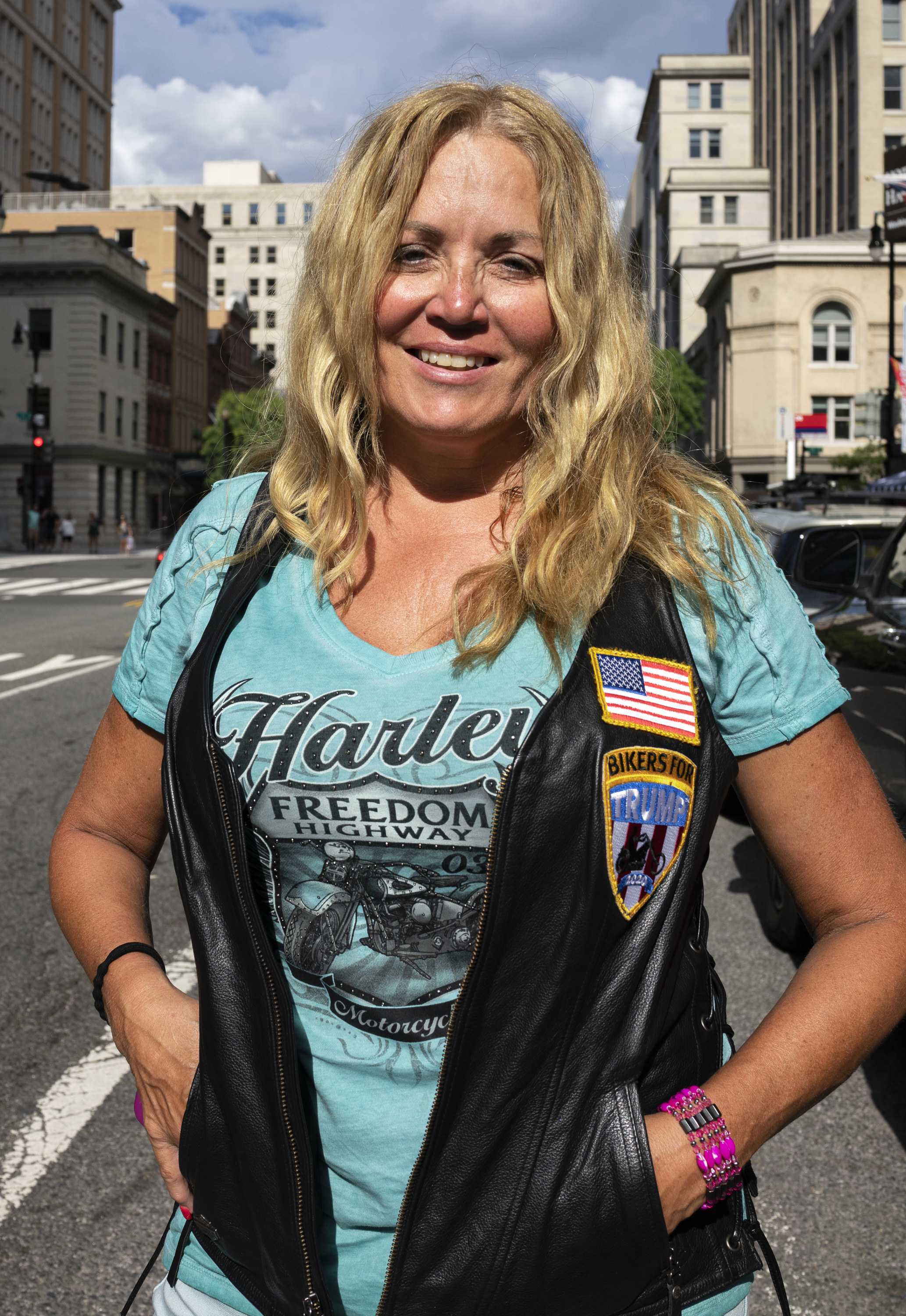
Londa Gatt, a member of Bikers for Trump.
Gatt told me she had just come back from the RNC headquarters, where she and other Biker leaders were being trained in voter registration techniques. Voter registration laws vary from state to state, and the Bikers were concerned about getting a “black eye” if anything went awry. I found this all a bit hard to fathom. She was a mother of three boys, paying for all this travel with the help of a second husband and a smattering of none-too-glamorous part-time jobs. I asked if politics had become her day job now. “Well, that’s what my husband thinks,” she said. “I travel a lot.”
It seems to be worth it to her, because she fully believes Trump is the only person capable of saving America from a dark alliance of socialists, Black Lives Matter activists, undocumented immigrants (who she believed were being imported to supply Democratic votes), and Muslim congresswomen. “He gave us hope,” she told me, “that America was not going to be overtaken.”
She’d recently organized a protest outside a town hall hosted by Detroit-area Rep. Rashida Tlaib, who is a particular target of the Bikers’ fear and derision. Gatt told me she’d been punched by a counterprotester, a woman who was later arrested, at a Republican event in Royal Oak, Michigan, in 2017. “Buncha snowflakes,” she said. The police were trying to keep the two groups separated. “Every time they got on that stupid bullhorn running their mouth, I just had all the Harleys just go and drown them out. She was so pissed. She snuck over and snuck up between the flags and boom” — she mimed a sucker punch. Gatt was livid, but Cox forbade her from retaliating. “He said we have to represent the president,” she said. “I said, ‘But this is a president who isn’t presidential that way. He doesn’t take shit.’”
I asked her what would happen if Trump didn’t get reelected. Her eyes widened noticeably. She didn’t seem to have ever contemplated the thought. “I would be devastated,” she said slowly. “Even my kids, they laugh because I’m so passionate about it. I start talking to them and I’ll start crying. I’m like, you guys don’t understand what’s happening to America.” I saw her cry quite a few times over the next few days. When I kidded with her that for a tough biker she seemed to break into tears a lot, she thought for a long time.
“I just cry about my country,” she said.
I asked her what concrete policies or accomplishments she hoped to see from Trump in the coming years, and she looked briefly at a loss. Not because she didn’t have ideas but because to her, like almost all the Bikers I posed it to, the question seemed to be missing the point of Trumpian politics: She was fighting a war about culture, race, and what sort of vision of America holds sway in this country. The point was for her side to hold power. “Trump’s got to get in and get reelected,” she said. “And we gotta get control of Congress and the Senate.” She figured that only then would Trump really be able to deliver on his promises. No one I talked to that weekend seemed animated at all by the anti-elite sentiments that supposedly feed the Trump movement. I asked Gatt at one point if she thought the monied elite had too much power over politics and if Trump could do something about it. “I don’t know if he’s even thought about it,” she said. “If I get a chance to talk to him tomorrow, I’ll mention it to him.”
Her friend Lisa Julian, a russet-haired and bombastic Navy veteran who grew up in Detroit and lives in Virginia, came and joined us. “What kind of shit is she saying?” Julian asked. They hugged. “This is my partner in crime,” Gatt said. They started showing off pictures and videos of themselves or Chris Cox posing and riding motorcycles with Trumpist candidates the Bikers had worked for — Corey Stewart in Virginia, John James in Michigan, Jim Renacci in Ohio.
Julian lingered as Gatt headed up to shower and fix her hair. She is a regional moderator for the eastern states and, like almost all the Bikers I’d met, had never been involved in politics before. “I got involved when Trump decided to go down that escalator,” she said. “I went to high school. It was 60% black,” Julian, who is white, said. “And then Roots was played, and you had to wear your rings the next day, because why? ’Cause you’re white, I’m kickin’ yo ass. Well, bring it, bitch.”
She didn’t try at all to hide what this was all about for her. “You got a black man reached the highest office in the land. Get the fuck over it. Or like this Kaepernick shit. I wanna choke that stupid white boy. He’s a white boy! Oh, his daddy was black — ’scuse me.”
“I used to run a football pool,” she said. “I’ve been running it for 12 years. Twenty dollars a block, 10 dollars a block. They’d all come to us. But I don’t watch football no more. He’s complaining he’s suppressed — what are you suppressed for, you rich motherfucker?”
This conversation was the first time I really understood how Trump inspires the feelings he does. It was baffling at first to see how often conversations I had with the Bikers that weekend turned to Kaepernick. There is no single executive order a president can issue or law Congress could pass to fulfill the desires of a voting bloc that wants to see an America where black men stand and show respect to the flag and the country when they’re told to. But the simple fact that Trump occupies the office is an assertion of the cultural and political power of his supporters, and no one can pretend that away. The irony is that Julian would probably agree with the most uncompromising anti-racist activists on at least one point: Before Trump, the entire structure of our politics and media had embraced the idea that talk about racial conflict just came from dinosaurs who hardly had a place in the new globalized rainbow America. But people like Julian are America, or at least a large part of it, and Trump is proof. On this level, he doesn’t have to do anything at all to please these core supporters; the fact that he’s in office proves the ascendancy of their values. His presidency is an end in itself.
“I’m a Christian,” Julian said. “I swear, I smoke, I drink — OK, God? I’m sorry. I’m a work in progress. But I still don’t want it taken away.” In this case, “it” means the moral underpinning of a country built, as she saw it, on shared values of Christianity and the patriotic belief in America as the greatest nation that ever was. And she was clear about what would happen if Trump isn’t reelected.
“You better hang on, buddy,” she said. “Because it’s gonna be a fucking riot, and it’s gonna get ugly. I think it’ll be a revolution.”
Gatt came back — hair straightened and now in her full biker regalia, and they went off to the diner on the other side of the hotel lobby where the Bikers and some of the Proud Boys and various other guests were gathering. I tried to go in too, but was barred by a man who told me that I was the reason the event was closed to the media. When it was over and everyone came back to the bar, there was a wave of excitement. “I got a golden ticket!” Balazek yelled. Trump had given the Bikers a block of VIP tickets to his speech, and this whole carousing crew was going to be onstage at the Lincoln Memorial with the president. Everyone was nearly quivering with excitement.
On the patio outside Harry’s, a father was finishing up dinner with a son who couldn’t have been more than 8 years old. The man told his son to look around and remember what he saw: “I brought you here so you would know what it feels like to be a man who can say what he wants. You can’t do this back home.” Half the bar rose up and looked around awkwardly as the loudspeakers from the Trump Unity Bridge began playing “The Star-Spangled Banner.” They were still standing, hats reverently removed, when the next song turned out to be the “Macarena.”
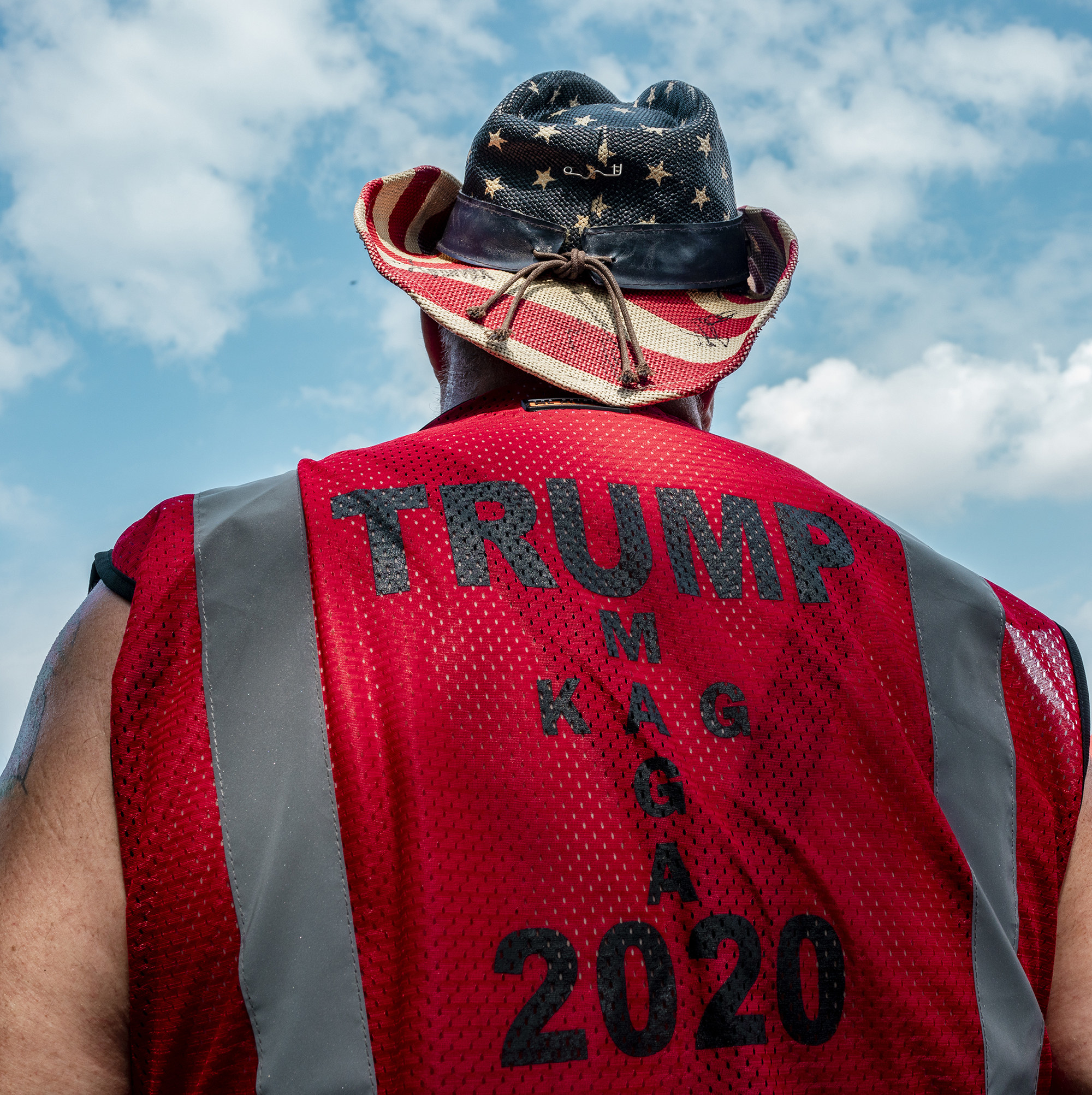
A man attending the Moms for America rally.
The Bikers began their 4th of July with a group breakfast at the Harrington’s lobby diner, and then headed off to the Capitol lawn for a small “Rally Against Socialism” hosted by a group of Trump-supporting mothers whose children have died while serving in the military. It was brutally hot, even at 10 a.m. And by then, Robert, the photographer I was working with, and I were very much personae non gratae, at least among most of the Bikers.
“I’m just going to warn you,” Gatt told us when she saw us there. “The decision is no talking to you guys. So just be careful how you approach anyone if you do. OK?” The sense of icy unwelcome we were getting from Cox’s second-in-command Dale Herndon and most everyone else as they stood around in the grass had now grown stronger; though, to be fair, no one said an offensive word to us. “I have to be clear that I can’t tell you anything,” she said. “There is just a lot at stake right now.”
If the 15 or so other bikers hadn’t shown up to this rally on the lawn, there would have been hardly anyone there. But this did not seem to matter. It was hosted by Rose Tennent, a well-known conservative talk radio host and frequent talking head for Fox News and CNN, who that day had just sat in for Sean Hannity. Actor Jon Voight came and gave a short speech. The event was livestreamed in coordination with Breitbart. The most poignant and dramatic story, told by a Cherokee woman named Amanda Jacobs whose son was killed in Afghanistan, was cleverly repurposed (using a shot facing the Capitol so you couldn’t see how small the crowd was) for a five-minute culture-war spot on Fox News later that night with the headline “Gold Star Mother Slams Colin Kaepernick.” Producers lasered in on one of Jacobs’ lines: “Colin Kaepernick gets paid $14 million a year to throw a ball — my son died for $14,000 a year, and he gave more than any football player ever has.”
About halfway through the proceedings, a hippieish-looking guy on a bicycle, flying a big flag with an x-ed-out swastika and the words “Impeach der Führer” on it, rode straight onto the Capitol lawn and right behind one of the mothers speaking, so he and his flag would appear on camera. Without a word, the Bikers moved into action, and within seconds they made a half-circle around him, barely inches from his face. It was striking to see how at ease they were with using their bodies as a form of intimidation, barely even needing to exchange glances before they knew what to do.
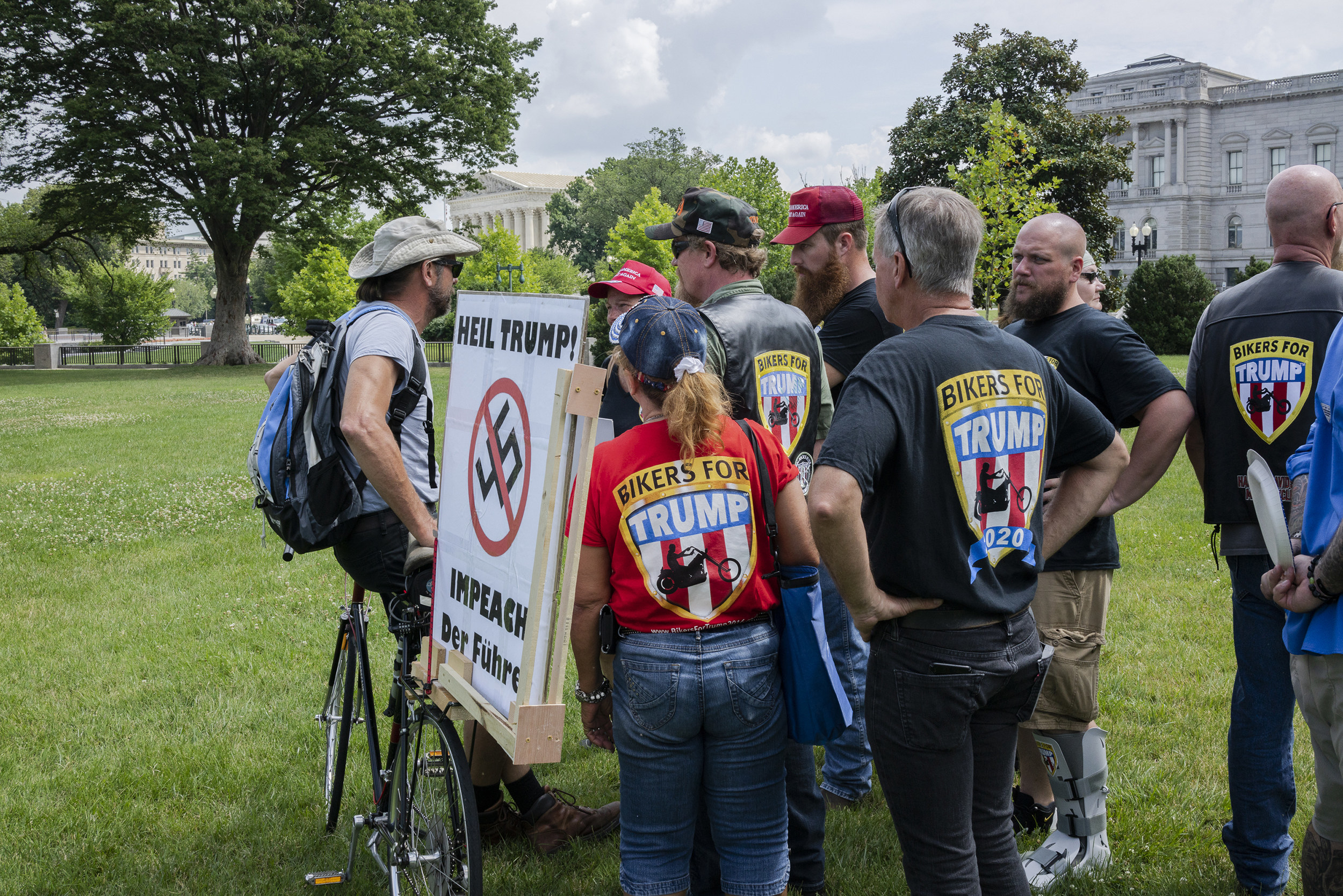
Bikers for Trump block the sign of an anti-Trump protester during the livestream of Moms for America’s stand against socialism rally.
Later, Voight mingled and posed for pictures with the black-vested Bikers. A few yards away, an extravagantly bejeweled woman held the leash of an old, fat golden retriever who had achieved some kind of internet celebrity after being photographed with a Trump sign in his mouth at a rally. She was talking to a profusely sweating and grizzled man named Randal Thorn, a prominent member of Trump’s gang of “Front Row Joes,” a crew of die-hards who show up early, usually sleeping overnight, to secure the first spots in line at rallies. “I need to get him a cab,” the bejeweled woman said, motioning to the dog. “It says on Twitter that antifa is going to try to target him today.”
Part of what’s interesting about the Bikers is how they have grown into something quite different than a thuggish “private political militia,” as New York magazine described them. But they are playing to two audiences at once: the public and the president. And Trump clearly revels in having a force of tough people who are personally loyal to him.
“They’re so lucky that we’re peaceful,” Trump said at a campaign rally for Sen. Josh Hawley in March. “These are great people. But they’re peaceful people, and antifa and all — they’d better hope they stay that way. I hope they stay that way. I hope they stay that way.”
I approached Voight to ask him about the incident with the bicyclist. “Are you a friend?” he asked me. “Or an enemy?”
“Well, I’m a reporter,” I said.
“So you’re an enemy,” he said, and brushed me off.
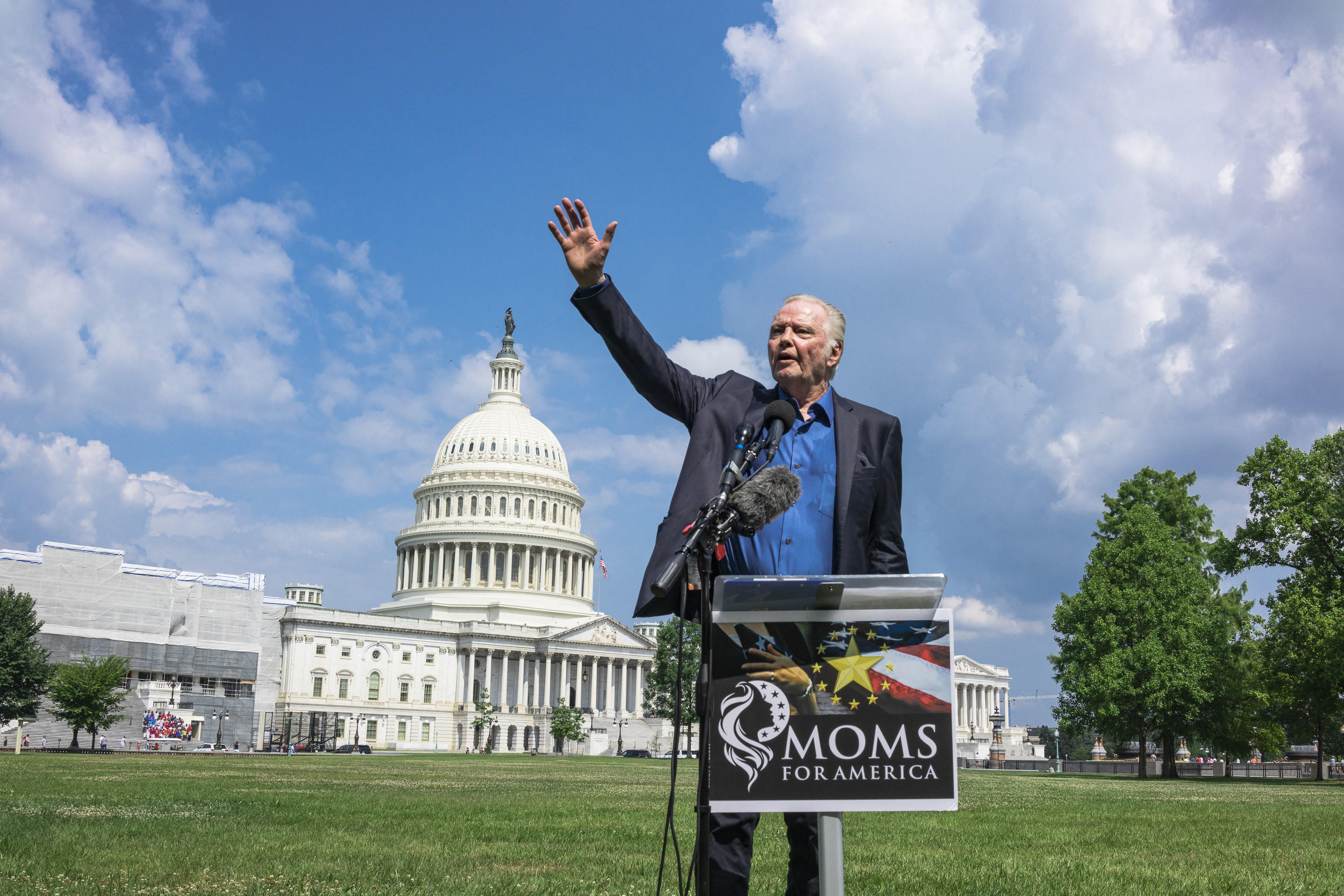
Jon Voight speaks at the rally of Moms for America’s stand against socialism in front of the Capitol.
Three hours later, having walked all the way from the Capitol, past the official White House 4th of July parade, I ran into Chris Cox again, walking alone and carrying a US flag at the head of a detachment of Cowboys for Trump proceeding on horseback towards the Washington Monument. I continued walking and took my place in a massive crowd of people caked in mud and drenched by a thunderstorm that had sent them fleeing from blinding rain and crashing lightning across the National Mall. A rumor had gone around that because of the weather, free tickets to Trump’s speech were being given out and fans could get closer to the Lincoln Memorial. Young men were trying to crash the gates as DC police, Secret Service agents, and military police tried to keep things under control. A guy in salmon-colored shorts got very close to a cop and held up his finger. “Do you know how much I pay in taxes?” he asked, sneeringly. “I guess that’s not good enough.”
A group of Black Israelites got into it at one of the gates with a bunch of young men wearing “Jews for Trump” T-shirts, each group shouting “You aren’t Jews!” back and forth as the sodden crowd passed them by, while a constant, inescapable, deranged loop of John Philip Sousa marches played over the loudspeakers. I talked briefly with a pair of Spanish tourists who said they’d come just to see the fireworks and looked bedraggled and shell-shocked. “America is so much more than I knew,” one said, and I understood the sentiment exactly.
As Robert and I worked our way to the very front of the general admission area, hundreds of people were chanting “Umbrellas down! Umbrellas down!” to shame anyone who was still trying to save themselves from the rain. Only one defiant blonde teenage girl continued to hold hers up, refusing to sacrifice her hairdo just so people could have a better view of a big screen. The roar that arose at the video stream of Trump’s motorcade leaving the White House seemed a bit much given that it was just a livestream of some cars, but honestly even I was a bit thrilled — we’d been there for four hours now, soaking wet and on our feet without rest, and at least something was happening.
Trump’s speech was as dark as the sky, and the crowd cheered loudest at the parts where Trump cited kill figures from famous battles and delivered punchy and brutal one-liners, reaching a sort of fever pitch as he recalled the glories of the Allied carpet-bombing of Germany. “And, as President Roosevelt said, ‘The Nazis built a fortress around Europe, but forgot to put a roof on it,’” he quoted with relish. Meanwhile the black wraith of a B-2 bomber screamed out of the thunderclouds. The crowd roared and turned toward the president’s imperial podium. “Dude,” Robert said, nudging me and pointing to the giant screen. “That’s Londa’s headband.” He pointed to the giant screen, where Gatt and Chris Cox had been placed barely feet away from the president. We hadn’t noticed before because of the mess of rain on the bulletproof glass separating Trump from the crowd, but once we saw her rhinestones it was obvious.
By the time we got back to Harry’s after the speech, all hell was breaking loose. Outside the White House, the Proud Boys had got into a street battle with some Revolutionary Communists, who triggered them by burning a US flag. The police had shut the area down, and now the Proud Boys seemed to have an excess of adrenaline. One was running around, wearing nothing on his torso but a body armor vest, chanting “Proud Boys! Proud Boys!” while a group of beautiful young women followed behind him, giving out high fives to middle-aged men in Trump hats. John Balazek had somehow already made it back to the bar and was deep into one of his pitchers of beer. “Us up there with him just goes to show Trump likes regular bikers as much as he does big elites,” he said.

Left: An excited crowd at the Lincoln Memorial after a long wait for the arrival of President Trump. Right: An iPhone photo from a Bikers for Trump member sitting behind the president during his speech.
The TV at the bar was playing PBS’s A Capitol Fourth live show, which seemed like it was coming from a bizarre and distant planet, with John Stamos hosting while Carole King and Sesame Street characters sang earnest patriotic songs to a crowd of well-behaved liberal boomers. Just off camera from this happy fantasia, throngs of red-hatted partiers were spilling off the Mall, chanting, “Build the wall.” Fistfights were breaking out all around the Washington Monument. Cox came in as I was watching this, not acknowledging me as he ordered a round of drinks.
A few minutes later, as I was walking back from the restroom, I saw Gatt’s friend Lisa Julian, the regional moderator for the eastern states, sitting at a high table and looking as thrilled as a teenager just coming back from her first arena concert. “It was crazy!” she began telling me as Cox sidled up to the table on my left. “I thought we told you not to be talking to our people,” he said without humor. “We were just catching up!” Julian said.
“It’s not personal,” Cox said, and I said that I thought it was personal. In retrospect I could have kept this opinion to myself. Suddenly, a large man with gray hair and an angry mien whom I hadn’t noticed before said “Get the fuck out of here,” in a low, growling voice. I asked him to repeat this, because I genuinely hadn’t heard him. Suddenly he was almost on top of me, bellowing, “Get the fuck away. GET THE FUCK AWAY.” (Cox later claimed not to have known what was going on during the altercation.)
I didn’t immediately retreat, which led us into an awkward standoff a few feet from the table. The man yelled and spittle flew into my face. It became clear that either I was going to leave the bar or there was going to be a fight, so I went out to the patio. The gray-haired man came out and took up a position at a table across from me, glaring.
A short while later, Gatt came out. “I’m so sorry,” she said, pulling up a chair. “That didn’t need to happen.” Gatt’s best friend, Keith Conway, a 55-year-old divorced factory supervisor whose son was in the Navy, came out and stood by the table. “Some of us are just going to kind of stand watch,” he said. According to Gatt, Cox had just pulled aside Gatt and Julian. “He chewed me a new one,” Gatt said. “I told them I’m my own person. I can talk to anyone I want. I just feel bad.”
I asked her what it had been like to be onstage. “It was amazing!” she said. “But you know it wasn’t enough.” I asked what she meant. “I wanted to talk to him!” she said. I said she’d probably get her chance soon enough, and she agreed that was likely. “I get VIP a lot,” she said. “But this was the first time I’d seen him and Melania together, and they were just so beautiful.”
Last call came and went, and around us the partying reached a fever point. A Compton-based alt-right Latina activist with long braids punched a man for laughing at her. Men began running out into the streets and ripping their shirts off. A young woman exhorted the crowd to sing, and suddenly the whole patio started belting out a refrain of “God Bless America,” sung to the point of shouting. Enrique Tarrio, the chair of the Proud Boys, embraced and posed for pictures with Elsa Aldeguer, who introduced herself to me as the president of a group called Latinos 4 Trump. “I just organized the biggest anti-Muslim rally ever in California,” she told me proudly.
I’ve been writing about extremism and paramilitaries for a decade now, and I’d still never met any set of people so ideologically committed to their views as the people at Harry’s bar that weekend. I did not once get the feeling that there was any point or benefit in trying to talk politics or sharing my own worldview, and I found the political implications of this to be pretty dark. Everyone was drenched in sweat and beer, and the men’s restroom was an inch deep in vomit. It had been a big day. A tall, old man dressed up as Uncle Sam had appeared with a mic and a portable amp and was leading the last few people sober enough to follow along in one last shaggy rendition of the “Battle Hymn of the Republic.” I decided it was time for bed.
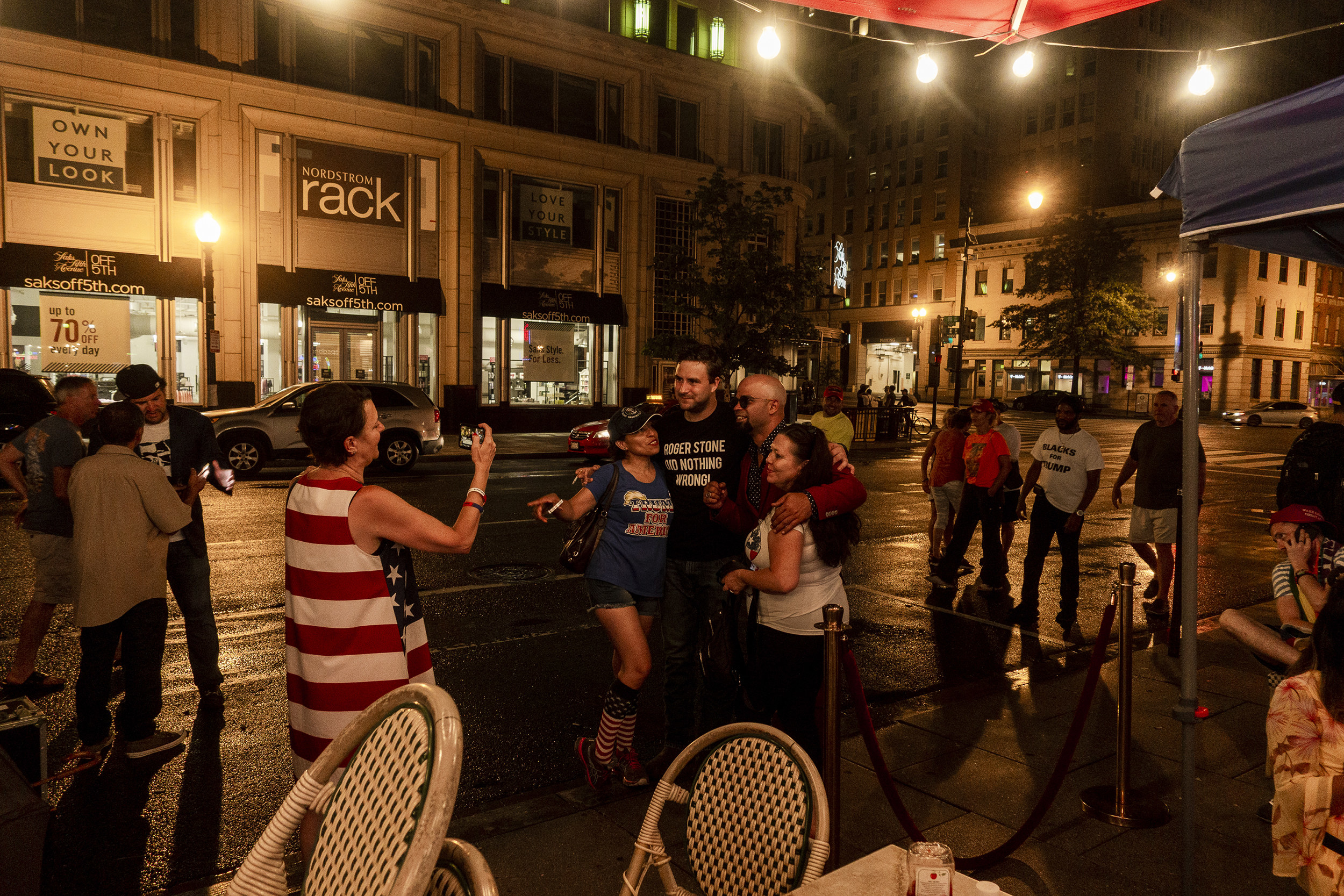
Enrique Tarrio, chair of the Proud Boys, takes a picture next to Elsa Aldeguer, a head member of Latinos 4 Trump, at Harry’s in Washington, DC.
The next day, July 5, I was eating lunch when I got a text from the young guy who’d barred us from the meeting at the diner, asking if I still wanted to meet with Chris Cox. I wrote back saying that Cox had given me reason to think that he probably didn’t want to talk. But it turns out he did, and wanted to do it soon.
At the diner at the Harrington, Cox was waiting in a brown leather vest, which had Trump’s signature weaving its way up one of the panels. He had an uneaten lobster roll in front of him and I ordered a coffee. Robert and I had walked about 10 miles the day before. Between the travel and the late-night reporting, it had now been four nights in a row during which I hadn’t managed more than a couple hours of sleep. My hand shook visibly as I took the mug from the server and I had to grab it with both hands to get it to the table without spilling. Cox noticed this, I noticed that he noticed, and he noticed that. Our eyes met in a sort of testy male way. He seemed as worn out as I was.
I did not know it then, but he was three days away from announcing that he was running for Congress back in South Carolina for the seat that until last year had been occupied by Mark Sanford. It may bear remembering that many people tend to think Sanford lost his seat because he broke publicly with Trump. We talked about Cox’s background and how he’d started the Bikers using the training he’d gotten working for Dan Quayle. He still wears a signet ring he received from Quayle, though he’s since replaced the vice presidential seal with a presidential one. “I picked up that mantle I left off at the Office of the Vice President,” he said with evident pride. “I became an advance man for my movement.”
I told him I was surprised he had built what seemed like an entire political movement without the help of or input from Trump’s campaign or the RNC. “It was hard not to be in touch with me,” he said about the RNC. “Because I’m at all the rallies, I have Bikers at all the rallies. Everywhere they went, I would have 200, 2,000, 4,000 Bikers out there in line. By then, I’m having signs printed out, the Bikers for Trump signs, and I’d contact the campaign. They wouldn’t have to contact me. I’m reaching out to them saying, ‘Hey, can I get these guys in there? Can I get any motorcycle parking in there, so we don’t have Black Lives Matter or antifa pushing the bikes over? Is there anything you can give me?’ To be honest, it was an uphill battle for a long time.” This was when the Bikers were showing up to rallies very much ready for trouble.
I raised a concern about the implications of a group dedicated to the interests of a single politician, whose members were willing, at least in theory, to serve as a parastatal force to protect those interests.
“We are certainly not there looking for a fight,” he said. “But if we see a woman or some elderly people that are being picked on — in our opinion, these groups are looking for soft targets. The Bikers are not a soft target, so they typically stay away from us. The Bikers, about 7, 8 out of 10 of them are probably carrying, OK? They’re not looking to come to us — so when we’d show up, typically it diffuses the whole situation.”
“Once then-candidate Donald Trump got Secret Service, things changed,” he said. “I was very careful. If I knew I had three, four, five hundred bikers coming up to Pennsylvania, I would go and sit down with the state police and say, ‘Listen. I need your help. How can you help me make sure that these guys don’t clash?’”
As we spoke, Cox was, after all, about to mint himself as a congressional candidate, so it’s not surprising that he might want to talk less about walls of meat or knuckle sandwiches than he had in 2017. “These are guys that are blue-collar. These are veterans. They’re not looking for a fight,” he told me.
Instead, Cox was more interested in outlining his plan for mobilizing voters in the next election cycle. “After 2016, I’ve been trying to build a political machine so that when 2020 gets full speed, I’ll be able to do it a lot easier than I did it the first time. My national guys are going to have five or six states, and in those states they can work along with the campaign.”
Cox was very proud of what he saw as his ability to find and mobilize new and unexpected blocs of Trump voters, just as he had with bikers. “The bikers are getting ready to deliver the Amish, the Mennonite,” he told me.
And he knows just what to say to animate the people he finds. “I go in there and talk to them on biblical principle, because that’s what they know, and they’re not politically active. I go in there and start talking to them about abortion. Boom — I shatter the all-time record-high voter registration for the midterms.”
I asked if he thought Trump could lose in 2020. “I think the left are shooting themselves in the foot,” he said. “I think they care more about noncitizens than they care about our citizens. I think they care more about criminals than they care about law enforcement.”
It was a very strange reversal to talk to Cox — and to all the Bikers — because for all the stories painting them as thuggish vigilantes they seemed to believe very passionately that they are one of the few bulwarks left against chaos and violence. Cox set up a hypothetical comparison of the Bikers to Black Lives Matter: “You ask a Democrat or Republican that’s watching television, ‘Who would you rather be neighbors with?’ They’re going to say, ‘I’d rather be a neighbor with that Biker for Trump. He’s not looting stores. He’s not burning down pharmacies. He’s not calling for the death of a police officer. That’s the guy I could trust to come over to my house and feed my dog.’”
Of course, being the kind of guy a respectable middle-class person would trust to come over and feed the dog has never prevented anyone from being a political enforcer.
In a way, that’s the whole point: The thought occurred to me of how in 1970, hundreds of hardworking and respectable Nixon-backing construction workers chanted “USA All the Way” and “America: Love it or Leave It” while they attacked anti-war protesters in lower Manhattan as NYPD officers mostly stood by. “Do you ever notice [antifa] pick on certain people?” Trump said at a White House event just a week after I talked to Cox. “They don’t go after Bikers for Trump,” he went on. “They don’t go after our construction workers who love us.”
I kept circling back to what he’d do if Trump lost in 2020. He genuinely didn’t seem to have considered the possibility. “He’s not going to lose,” Cox said. “They already stacked the cards against him and he won.” I asked if he thought Trump could lose a fair election. Chris Olmstead, the young man who would soon take up the role of his congressional campaign manager, sensed danger and interjected.
“Oh, I hear you,” Cox said. “You don’t have to talk around and try to trick me,” thinking that I’d been trying to get him to say that any election Trump didn’t win would be illegitimate. “I’ll answer any question you ask.
“Listen, we’re not out there looking for a problem. If one falls in our lap, we’re going to deal with it as patriots. We’re going to stay within the framework of the law in any way we deal with it.”
This did not really answer the question. It was not to trick him into advocating violence, but rather to try to understand where a movement of almost 100,000 people — shaped in the fire and chaos of the 2016 elections, who passionately believe that they represent a last stand for their America, and loyal exclusively to one man — might go from here. If Trump wins, they are a phalanx of loyalists in an ongoing revolution. If he loses, well, it’s hard to say what exactly will happen to the Bikers or in the country at large. But it was impossible to be in DC that 4th of July weekend and imagine that this movement would somehow disappear. They were born out of opposition. Anyone who thinks that the next election will take things back to where they were is kidding themselves. This is only the beginning. ●
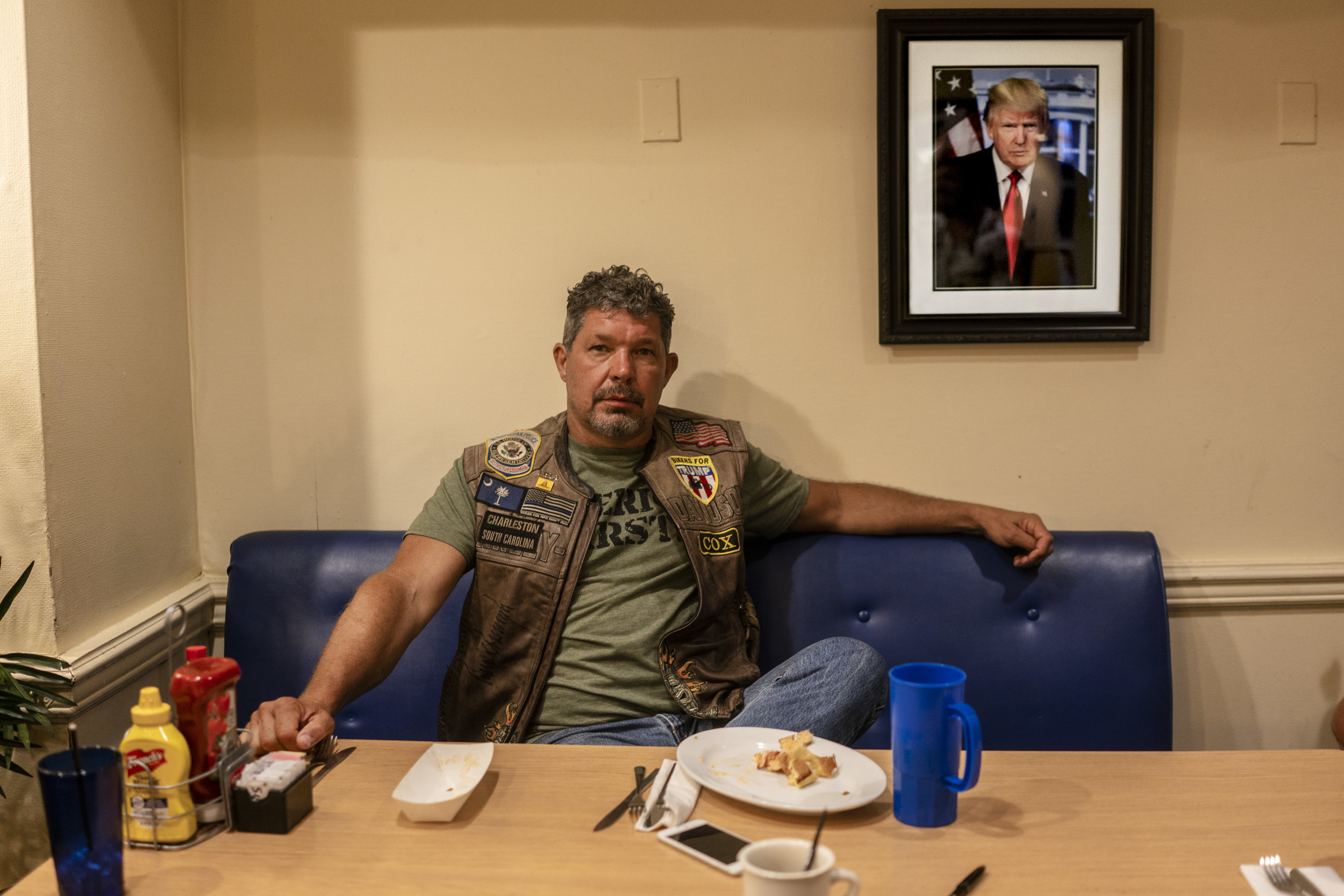
Chris Cox, the founder of Bikers for Trump, poses in a diner booth at Harry’s.
James Pogue is the author of Chosen Country: A Rebellion in the West. He has written for Harper’s, the New York Times magazine, and others.
- Donald Trump
- Republicans
Source: Read Full Article
